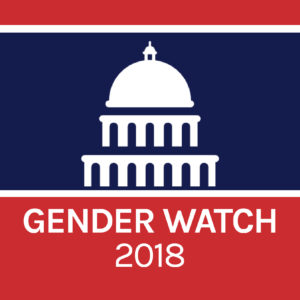There was no wave for Republican women this year.
 From March to December 2018, the Barbara Lee Family Foundation (BLFF) and the Center for American Women and Politics (CAWP) partnered to offer Gender Watch 2018, which tracked, analyzed, and illuminated gender dynamics in the 2018 midterm elections. With the help of expert scholars and practitioners, Gender Watch 2018 furthered public understanding of how gender influences candidate strategy, voter engagement and expectations, media coverage, and electoral outcomes in campaigns. The blog below was written for Gender Watch 2018, as part of our collective effort to raise questions, suggest answers, and complicate popular discussions about gender’s role U.S. elections.
From March to December 2018, the Barbara Lee Family Foundation (BLFF) and the Center for American Women and Politics (CAWP) partnered to offer Gender Watch 2018, which tracked, analyzed, and illuminated gender dynamics in the 2018 midterm elections. With the help of expert scholars and practitioners, Gender Watch 2018 furthered public understanding of how gender influences candidate strategy, voter engagement and expectations, media coverage, and electoral outcomes in campaigns. The blog below was written for Gender Watch 2018, as part of our collective effort to raise questions, suggest answers, and complicate popular discussions about gender’s role U.S. elections.
By most accounts, last week’s midterm elections were historic for women. For the first time, the U.S. House will have more than 100 women serving; voters elected the most diverse, young members of Congress in our nation’s history. Those numbers are echoed at the state legislative level as well. A record number of women – over 2000 – will serve in state legislatures in 2019.
While many news outlets rightly trump these historic developments, less noted is the fact that one group of women did not enjoy much success: Republican women. As of this writing, only 13 of the women elected to the U.S. House this fall are Republicans. That means that there will actually be fewer Republican women serving in Congress come January. And it appears that their numbers have also gone down in state houses around the country. What gives? In this historic year of the woman, why did GOP women perform so poorly?
In my book Tea Party Women, which examined the important leadership role of women in the Tea Party movement, I argued that the government bailout of failing banks in 2008, the passage of Affordable Care Act, and the election of Barack Obama—and, in some cases, Sarah Palin’s losing bid to become Vice President—inspired many conservative women to become engaged in politics for first time. Combined with their many personal resources such as professional experience and high education levels, many of the Tea Party women I interviewed adeptly used social media to organize fellow conservatives at the local, state and national level, allowing conservative women to develop the sorts of civic and organizational skills that would potentially make them attractive candidates to the GOP. Indeed, at the height of the Tea Party movement in 2010, some conservative women did ride a Tea Party wave to elected office, including South Dakota Representative (and now Governor-elect) Kristi Noem and former South Carolina Governor Nikki Haley. Given that these right-wing women had the requisite skills and passion to be such an influential force within conservative activism, why haven’t we seen greater numbers of such women enjoying record levels of electoral success within the GOP?
While my research showed that women were finding success as organizational leaders in the Tea Party, it also highlights ways in which many of these women felt alienated or rejected by local or state Republican Party networks. Some of the women I interviewed felt compelled to start their own Tea Party groups precisely because of the “good ole boy” nature of the GOP. Even during a time of record-breaking triumph for conservative politics, driven in part by white women voters—remember that in 2010, Republicans won huge majorities not just in Congress but in state legislatures across the country—there’s scant evidence that the GOP was actively recruiting women as potential candidates.
My findings comport with the research of other political scientists who have studied the tougher climate that Republican women face in seeking elected political office. Compared with the Democratic Party, the GOP does not prioritize electing women to office. One case in point—fundraising. For example, Melody Crowder-Meyer and Rosalynn Cooperman find that Democratic donors are far more motivated by the gender of the candidate when considering campaign contributions than are Republican donors. They also find that while there are a few conservative women’s PACs, they are virtually invisible to Republican elite donors. By contrast, organizations such as EMILY’s list and other Democratic organizations to support women candidates are well funded and extremely success in helping women get elected.
Once Republican women decide to become candidates, they face an electorate that is not nearly as open to female candidates. Last summer (June 2018), I asked likely voters in a national Qualtrics poll whether they thought that the country would be better off if we elected more women to public office. More than two-thirds (67 percent) of Democrats agreed, compared with just 37 percent of Republicans. This data point is just one more piece of evidence that Democratic voters prioritize women candidates while Republican voters do not.
Even when very conservative women run in Republican primaries, Republican voters often assume that women candidates are more likely to be moderate than their male opponents, which may advantage male candidates more broadly in Republican primary contests. So, Republican women are less likely emerge through the nomination process than are Democratic women.
Finally, this election season may have been particularly demoralizing to potential Republican women candidates, who realized that while the gender dynamics brought to us by President Trump animated many women on the left, it worked in different ways on the right. Retiring Republican House member Ileana Ros Lehtinen, told Politico this fall that Republican women are an endangered species: “The base is with Donald Trump, and he can do no wrong. … He’s going to be hanging on you like an albatross around your neck. Ugh! It is a real knot for female candidates.”
This is not to say that there were no bright spots for GOP women this election cycle: Marsha Blackburn convincingly won her Senate election to become the first woman Senator from Tennessee and Kristi Noem will be the first female governor of South Dakota. But the success of these GOP women appears to be the exception rather than the rule.
If you cared to look beyond the headlines, this year’s results put the persistent (and deepening) dearth of Republican women in office into stark contrast with the continued growth and record success of Democratic women, particularly at the national level. Not all women caught an electoral wave this year, and the tide looks slow to change.


